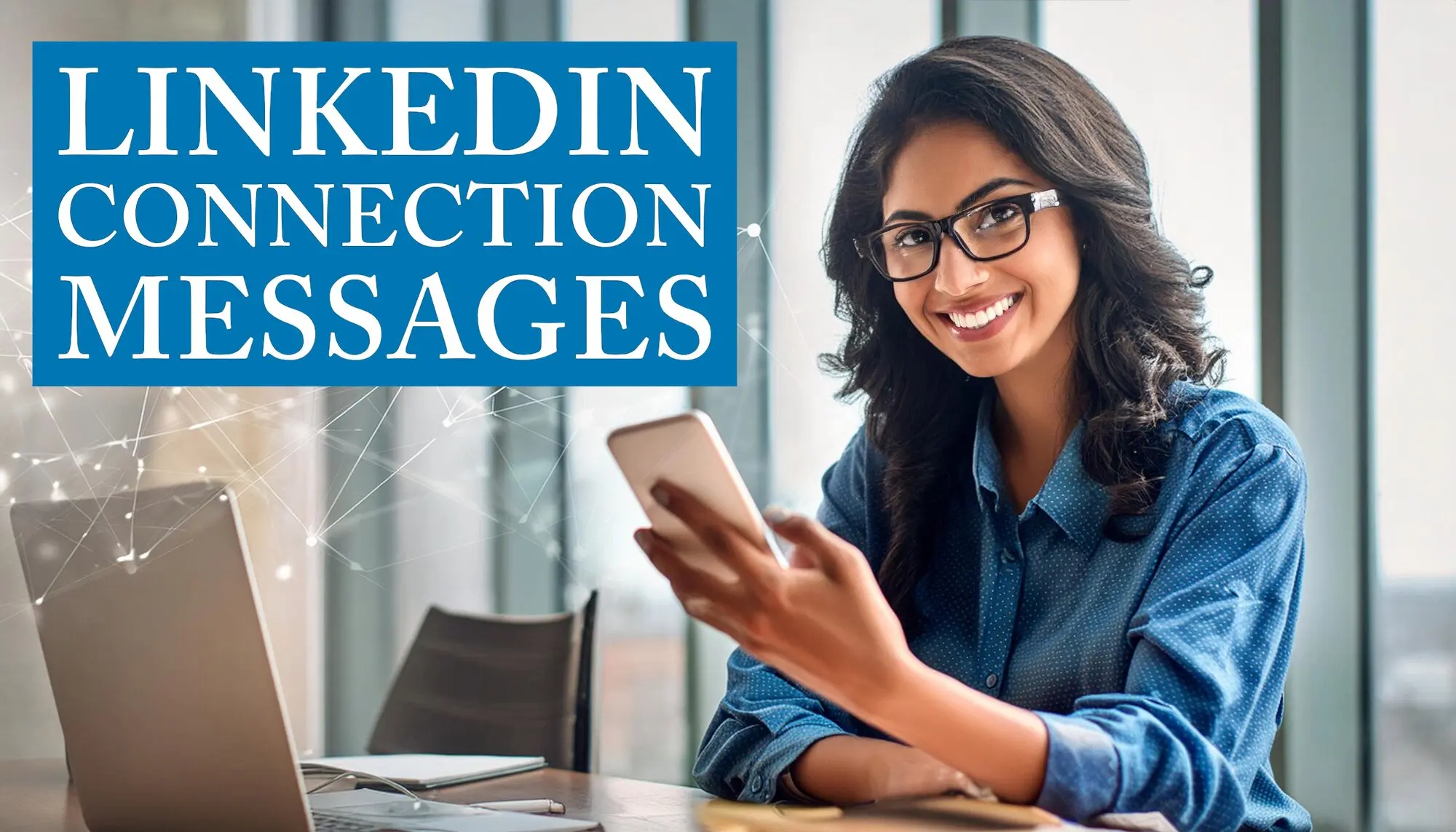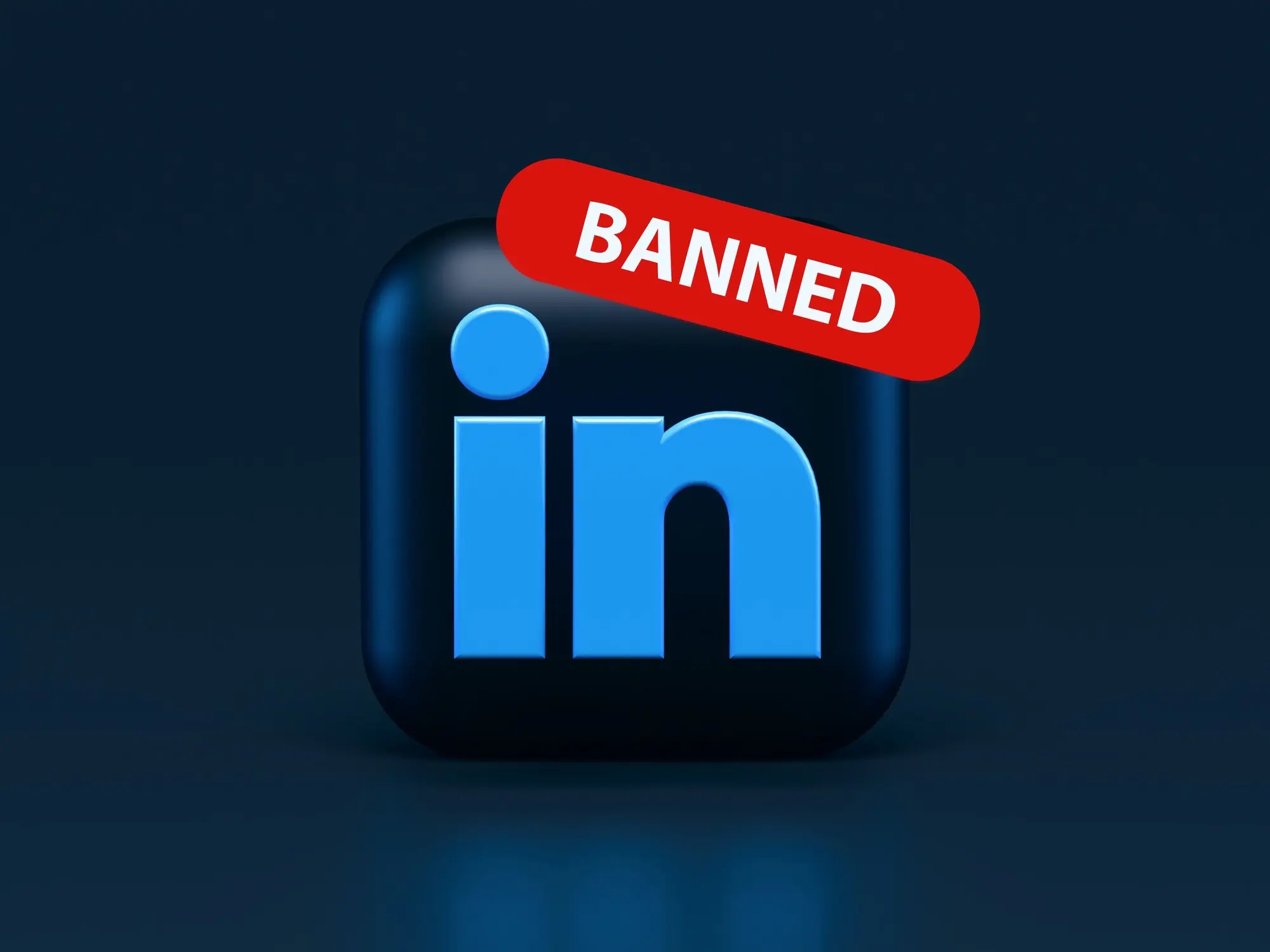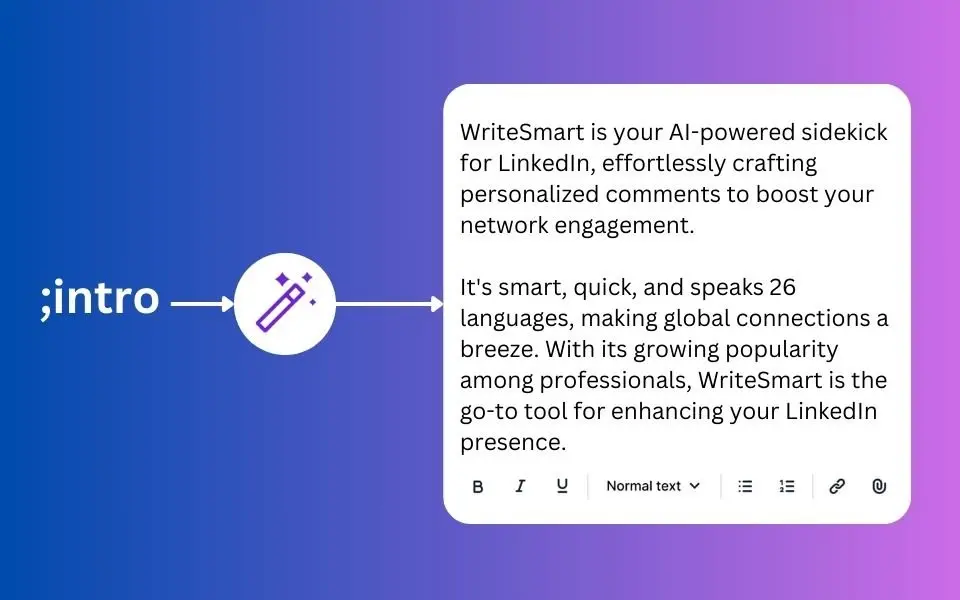06/29/2024
So, you've set up your profile, picked the perfect headshot, and now you're ready to dive into the world of professional networking. But hold up – there's one tiny detail that can make or break your LinkedIn game: your connection message.
You know, that little note you can add when you're trying to connect with someone? Yeah, that's your golden ticket to standing out in a sea of "I'd like to add you to my professional network" snooze-fests.
Let's break down how to craft a connection message that'll have people hitting "Accept" faster than you can say "synergy."
What's the Big Deal with LinkedIn Connection Messages?
First things first – why should you even bother with a custom message? Well, let me paint you a picture:
Imagine you're at a networking event (remember those?). Would you walk up to someone, stick out your hand, and just say, "Connect with me" without any context? Nope, didn't think so. That'd be weird, right?
Your LinkedIn connection message is basically your virtual handshake. It's your chance to make a killer first impression and give the other person a reason to welcome you into their digital circle.
Plus, let's be real – we're all drowning in notifications these days. A personalized message shows you're not just another rando clicking buttons, but someone who's genuinely interested in connecting.
Breaking Down the Perfect LinkedIn Message
Alright, let's get into the nitty-gritty. Your message has a 300-character limit, so we've gotta make every word count. Here's the secret sauce:
1. The "Hey There!" (10-20 characters)
Start with a friendly greeting that fits the vibe. "Hello" works, but don't be afraid to throw in a "Hey" or even a "Howdy" if that's more your style.
2. The "Here's Me in a Nutshell" (50-70 characters)
Give a quick intro. Who are you? What do you do? Keep it short and sweet.
3. The "We've Got Something in Common" (60-80 characters)
This is where you show you've done your homework. Maybe you're in the same industry, went to the same school, or both love skydiving. Whatever it is, find that common thread.
4. The "Here's Why I'm Reaching Out" (80-100 characters)
Be upfront about why you want to connect. Are you looking for advice? Interested in their work? Want to collaborate? Lay it out there.
5. The "Ball's in Your Court" (30-50 characters)
Wrap it up with a clear next step. Maybe suggest a quick chat or ask a question.
6. The "Catch Ya Later" (10-20 characters)
Sign off in a way that matches your tone. "Cheers," "Thanks," or even just your name works great.
Putting It All Together: Your Step-by-Step Playbook
Now that we've got the ingredients, let's cook up some killer connection messages:
Now that we've got the ingredients, let's cook up some killer connection messages:
Step 1: Sherlock Holmes Mode (Research Your Target)
Let's kick things off by channeling your inner detective. Before you even think about typing that message, it's time to do some digging.
What to look for:
• Recent activity: What have they been posting or commenting on lately?
• Career history: Any interesting job moves or promotions?
• Shared connections: Who do you both know?
• Education: Same alma mater or similar academic background?
• Interests and causes: What groups are they part of? Any volunteer work?
Pro tips:
- Don't just skim their headline. Dive into their "About" section for juicy details.
- Check out their recent articles or posts. These are gold mines for conversation starters.
- Look for any awards or recognitions. Everyone loves a bit of ego-stroking!
Example: Let's say you're reaching out to Sarah, a marketing manager at a tech startup. You notice she recently posted about AI in content creation and is part of a "Women in Tech" group.
Step 2: Get Your Head in the Game (Define Your Purpose)
Alright, now that you've done your homework, it's time to get clear on why you're really reaching out.
Ask yourself:
• What's my end goal here? (Job opportunity, mentorship, collaboration, etc.)
• What value can I offer this person?
• How does this connection fit into my broader career goals?
Be honest with yourself. If you're just collecting connections like Pokémon, maybe reconsider your strategy.
Pro tips:
- Write down your purpose. It'll help you craft a more focused message.
- Think beyond the immediate. How could this connection benefit you both in the long run?
- If you're job hunting, don't just focus on open positions. Think about building relationships for future opportunities.
Example: Your purpose in reaching out to Sarah might be to learn more about AI in marketing and potentially collaborate on a project down the line.
Step 3: Break the Ice (Craft Your Opening)
First impressions matter, so let's make this opener count!
Key elements:
• Greeting: Keep it friendly but professional
• Your name: Don't assume they'll check your profile
• A hint at why you're reaching out: Pique their curiosity
Examples:
• "Hey Sarah! I'm Alex, a fellow marketing enthusiast diving into AI."
• "Hi Sarah, Alex here. Your AI content post caught my eye!"
• "Sarah, hi there! I'm Alex – another Women in Tech member fascinated by your work."
Pro tips:
- Match their tone. If their profile is formal, stick with "Hello." If it's casual, "Hey" works great.
- Avoid generic openings like "I'd like to add you to my professional network."
- Don't be afraid to show a bit of personality, but keep it professional.
Step 4: Find Your Common Ground (Establish a Connection)
Now's the time to show you've done your homework and you're not just another random connection request.
What to mention:
• Shared interests or experiences
• Recent activity you found interesting
• Mutual connections (if relevant)
• Similar career paths or industry challenges
Examples:
• "I saw your post about AI in content creation – it's a game-changer, isn't it?"
• "Looks like we're both battling the ever-changing world of martech!"
• "I noticed we're both part of the Women in Tech group. How are you finding it?"
Pro tips:
- Be specific. "I loved your article" is okay, but "Your point about AI ethics in marketing really resonated with me" is much better.
- If mentioning a mutual connection, make sure you actually know them well enough to name-drop.
- Avoid making assumptions. Stick to facts you've observed from their profile or activity.
Step 5: Lay Your Cards on the Table (State Your Reason)
Time to get to the point. Why are you really reaching out?
Key elements:
• Clear statement of your reason for connecting
• How it relates to their work or interests
• What's in it for them
Examples:
• "I'm reaching out because I'm working on an AI content project and would love to get your insights."
• "Your experience in scaling marketing teams is impressive. I'm at a similar stage with my startup and would value your perspective."
• "I'm organizing a panel on women in AI and your expertise would be invaluable."
Pro tips:
- Be honest. People can smell insincerity a mile away.
- Keep it concise. Remember, you've only got 300 characters total!
- Make it about them as much as it is about you. How can this connection benefit them?
Step 6: Sweeten the Deal (Offer Value)
Now's your chance to show them why connecting with you is worth their time.
Ways to offer value:
• Share a relevant resource (article, tool, etc.)
• Offer to introduce them to someone in your network
• Propose a mutually beneficial collaboration
• Share a unique perspective on their work
Examples:
• "I recently came across a great case study on AI in content that I think you'd find interesting. Happy to share!"
• "I'd be glad to introduce you to my colleague who's leading AI initiatives at [Company]. Might be a great connection for you."
• "I have some ideas on how we could collaborate to address the AI ethics challenges you mentioned in your post."
Pro tips:
- Make sure your offer is genuinely valuable and relevant to their interests or work.
- Don't oversell. A small, specific offer is better than grand, vague promises.
- If you're sharing a resource, make sure it's high-quality and not something they're likely to have already seen.
Step 7: Call the Shots (Suggest Next Steps)
Don't leave them hanging! Give a clear, low-pressure suggestion for how to move forward.
Possible next steps:
• Propose a quick call or virtual coffee chat
• Ask a specific question related to their work
• Suggest connecting at an upcoming industry event
• Invite them to check out your latest project or article
Examples:
• "Would you be up for a 15-minute Zoom chat next week to discuss AI in marketing?"
• "I'd love to hear your thoughts on how you've integrated AI into your content strategy. Mind if I send a couple of quick questions your way?"
• "I'll be at the MarTech conference next month. Any chance you'll be there too? Would be great to connect in person!"
Pro tips:
- Keep it low-commitment. A quick call is less daunting than an hour-long meeting.
- Give them an out. "If you're too busy, no worries at all!" shows you respect their time.
- Be specific about timing if possible. "Next week" is better than "sometime."
Step 8: Wrap It Up (Craft Your Sign-Off)
Finish strong with a sign-off that matches the tone of your message and leaves a good impression.
Sign-off options:
• "Looking forward to connecting,"
• "Thanks for considering,"
• "Appreciate your time,"
• "Cheers,"
• "Best,"
Examples:
• "Looking forward to geeking out about AI with you soon! Cheers, Alex"
• "Thanks for considering. I know how busy it gets in the startup world! Best, Alex"
• "Appreciate your time. Hope we can chat AI soon! -Alex"
Pro tips:
- Keep it consistent with your opening tone.
- Include your name again – it's a small touch that adds personalization.
- Avoid overly formal sign-offs like "Sincerely" unless the rest of your message is very formal.
Step 9: Quality Control (Review and Refine)
You're almost there! Before you hit send, give your message a final once-over.
What to check:
• Spelling and grammar: Use tools like Grammarly if you're not confident.
• Tone: Does it sound like you? Is it appropriate for the recipient?
• Length: Are you within the 300-character limit?
• Personalization: Double-check you've used the correct name and details.
• Call-to-action: Is your suggested next step clear?
Pro tips:
- Read your message out loud. It helps catch awkward phrasing.
- If possible, let it sit for a few minutes, then read it again with fresh eyes.
- Ask a trusted friend or colleague to review it if you're unsure.
By following these detailed steps, you'll be crafting personalized, engaging LinkedIn connection messages in no time. Remember, practice makes perfect. The more you do this, the more natural and effective it'll become. Now go forth and network like a pro!
Pro Tips for LinkedIn Message Mastery
Alright, you've got the basics down. Now let's level up with some advanced strategies:
1. Timing is Everything
Try to catch people when they're actually on LinkedIn. Weekday mornings or lunch hours are usually a good bet.
2. Name Drop (But Ask First)
If you've got a mutual connection, mention them – but make sure to get their okay first. Nothing awkward about that, right?
3. Show You're Paying Attention
Did they just post an article or get a promotion? Give 'em a shout-out! Everyone loves a little recognition.
4. Keep It Real
Use language that sounds like you. If you wouldn't say "synergize our core competencies" in real life, don't say it here.
5. Test the Waters
Try out different message styles and see what works best. It's like A/B testing, but for your social skills!
6. Follow Through
Once they accept, don't ghost them! Follow up with something relevant to your initial message.
Rookie Mistakes to Dodge
Even the best of us can slip up. Here are some common facepalm moments to avoid:
1. The Copy-Paste Job
Nothing says "I don't really care" like a generic message. Take the extra 30 seconds to personalize it.
2. The "Me, Me, Me" Show
Yes, you're awesome, but focus on how you can help them or what you have in common.
3. The Hard Sell
LinkedIn is for networking, not for pushy sales pitches. Save that for after you've built a relationship.
4. The Novelist
Remember that 300-character limit? Stick to it. No one wants to read a novel in a connection request.
5. The Typo Terror
Proofread! A message full of typos is like showing up to a job interview with your shirt on backward.
6. The Robot
Leaning too hard on LinkedIn's suggested phrases? Mix it up with your own words to sound like a real human.
Want to become a LinkedIn connection ninja? Keep track of how you're doing
1. Count Your Wins
How many of your requests are getting accepted? If it's low, might be time to switch up your approach.
2. Quality Over Quantity
Sure, acceptances are great, but how many people actually engage with you afterward? That's the real measure of success.
3. Ask for Feedback
Don't be shy – ask your new connections what made them hit "Accept." It's like getting the answers to the test!
4. Learn from the Best
Look at your most successful messages. What did they have in common? Do more of that!
5. Stay in the Loop
LinkedIn's always changing things up. Keep an eye out for new features or trends and adapt your strategy.
Wrapping It Up: Your LinkedIn Legacy Starts Now
And there you have it, folks! You're now armed with everything you need to craft LinkedIn connection messages that'll make people sit up and take notice.
Remember, at the end of the day, LinkedIn is all about building real relationships. Your connection message is just the beginning of what could be an awesome professional friendship.
So go ahead, put yourself out there. Be genuine, be interested, and most importantly, be yourself. Before you know it, you'll have a network full of cool people who actually want to chat with you.
Now get out there and start connecting! Your future work bestie could be just one message away. 🚀

Power of AI in your Social Networking




